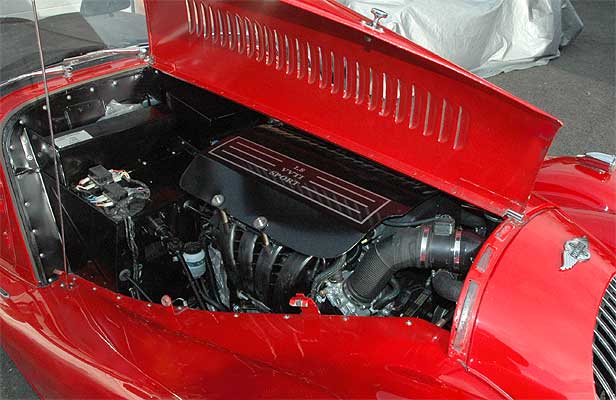 A
General Motors 4/4!
A
General Motors 4/4!
A few months ago, the Morgan Wire was approached with
an upgrade concept for older 4 cylinder Morgans. Approaches are common
in this corner but this one showed immense promise because of the players
involved. The drive behind the idea is Stewart Halstead, a creative British
professional with impeccable credentials within the UK automobile industry
for decades. Halstead runs the Partsworld
team of companies, suppliers to the General Motors marques. Stewart
picked Kevin Vernon of Tudor
Morgan Workshops, a concours restorer of extraordinary talent as his
main project pilot. Parts from other Morgan community notables were drawn
on as well as the immense Halstead/Vernon contact list, notably John Ravenscroft,
the ECU fuel mapping wizard. The goal was to create a FULLY comprehensive
upgrade package for the 4/4 while enhancing the inherent character of the
car, being emission compliant, easily parts sourced and all at a reasonable
price. The Company responsible for the package is called Morgan
Sport.
The RHD prototype result was presented to the Morgan Wire
in October (a LHD is presently in the works). For test drivers we
wished two individuals who are very familiar with their 4/4s as happy with
them as they are. We wanted the test to be as hard on the package as possible.
We called for volunteers (on eMog) and
were overwhelmed with the response. Here are the reviews from the test
drivers chosen. They are very different! We thank both Tim and Paul for
time they took on behalf the Morgan Wire and the Morgan community at large.
Lorne
Goldman
The prototype is a mid-80s Morgan 4/4, originally equipped
with a Ford engine producing 96 bhp (when new), with a 4 speed gearbox
with a kerb weight of 875 kilos.
The Paul Crighton Review
The Tim Harris Review
Report on a Test Drive of the
Prototype GM VVTi 1800 cc Powered Morgan 4/4
by Paul E Crighton December
4th 2007
Now it's my turn to road
test the GM powered 4/4 and after a good trip from home navigated by TOMTOM,
I arrived safely at Tudor's, Market Drayton works.
The 4/4 was ready for me
on arrival and a conducted tour of the project followed a cup of tea and
some interesting chatter with Kevin Vernon and members of his team and
family.
The test 4/4, a 1986
model with about 45,000 miles on was purchased specially for the conversion
by the instigator and sponsor of the project, Stewart Halstead and delivered
to Kevin at Tudor. Tudor checked all the running gear including front suspension,
strip down, clean and reassembly without change (bronze bushes).
Track rod ends were, however, replaced. Front brakes were upgraded
with 4 pot “HI Spec” calipers. After the test Kevin and I both wondered
whether the standard arrangement plus servo would have been better and
possibly more sensitive.
A brief pre-test check was
carried out and I noted new wheels and tyres (Firestone F560) and also
brake reaction bars had been fitted during the conversion from CVH to GM
1800cc VVTi motor. I noted also tyre pressures of 26/27 psig which,
with Kevin's immediate agreement, I reduced to 19 psig (his preferred figure,
mine is 18 psig.)
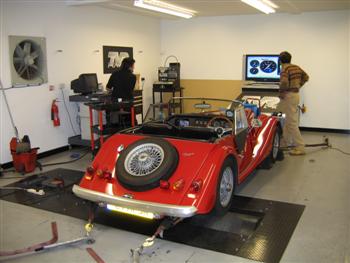
A simplified custom designed
ECU developed and refined by John Ravenscroft, the brains behind the TVR
AJP V8, is installed under the dash. All instrument details are standard
except for the addition of a MIL and a shift indicator lamps (neither operational
at the time of test). Throttle control was electronic but I found
no lag or difficulty in use and sensitivity was satisfactory.
Due to the nature of the
standard GM exhaust manifold it was deemed preferable to change the exhaust
system to the right hand side of the car and bring the tubing from the
junction at the manifold, via a short flex underneath and behind the step
in the sump through a largish circular hole cut in the vertical web of
the chassis rail. Such cut outs are not my favorite and perhaps a
method of keeping the entire system on the left hand side can be developed.
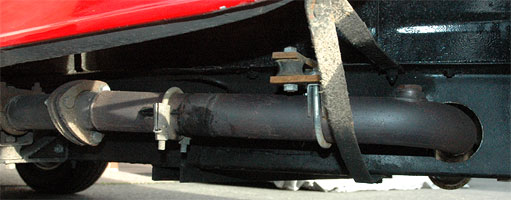
A lot of Stage 1 conversions
leave the air cleaner in the hot zone of the engine bay whereas the standard
system takes cool air in via the inner wing valence. The Tudor answer is
quite neat in that an air box is fitted under the cowl above the radiator
and the air is ducted from that point via the air flow sensor section
to the inlet manifold. The air filter/cleaner is temporarily a section
of the Tudor paint booth extraction filter material. Possible improvements
here for a high efficiency air cleaner whilst keeping the inlet air cold.
The cooling system incorporates
a remote pressurized header tank. The radiator header has a non relieving
cap. The relieving cap is fitted on the remote tank. This ensures
a completely sealed system which in turn means that the radiator header
tank remains full at all times, or would do if the small bore flex from
the branch on the radiator filler neck had been connected to the remote
tank below the water level. As it is the pipe is connected above
the water level spoiling the siphon effect and possibly introducing air
pockets in the system. There is a connection from the main cooling
water circuit into the bottom of the remote tank. If the radiator
header overflow pipe were connected at that level the other pipe may not
be required. KISS.
The complete engine and Omega
gear box assembly fit neatly into the engine bay set back about 2” further
than the former CVH. The Omega box was part of a rear wheel drive
set up so should be fully developed. The changer linkage provides
for a short and positive throw and is closer to the driver's knee than
the T9 Ford Sierra changer, very handy and slick. The ratios are
similar to the Sierra box but in the test first gear was a bit of an embarrassment
and would be only really useful on very steep uphill starts. The clutch
is hydraulically operated
The engine bay is workmanlike
and a rain shield has been neatly fabricated to cover the top electrics
over the twin cam covers. Everything that needs to be easily accessible
seems to be so.
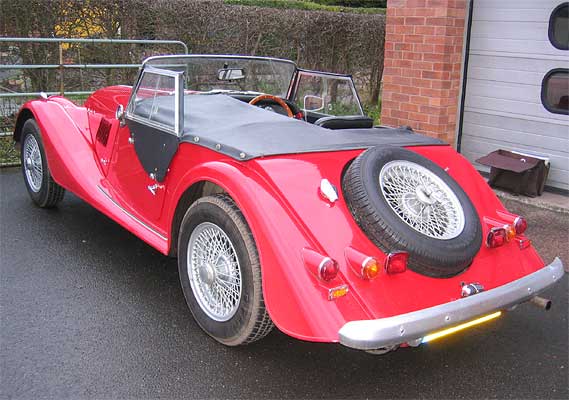 Once
seated in the car with hood down and ¾ tonneau in place it only
remained to familiarize myself with the difference between the test car
interior and my own. Seating was not quite as I would like being
used to fully adjustable plus 8 type seats in my own 4/4/4. Gear
lever position felt good, pedals OK, apart from lack of rubber on the brake
pedal.
Once
seated in the car with hood down and ¾ tonneau in place it only
remained to familiarize myself with the difference between the test car
interior and my own. Seating was not quite as I would like being
used to fully adjustable plus 8 type seats in my own 4/4/4. Gear
lever position felt good, pedals OK, apart from lack of rubber on the brake
pedal.
Instruments OK. The speedometer
was correctly calibrated by satnav overlays at 20, 40, and 60 mph.
I fixed my own new TOMTOM to the screen and proceeded into the Shropshire
countryside. Weather was dull, road surfaces damp, air temperature
12 C.
Full lock seemed more restricted
than on my own car but the test car was fitted with roller stops which
may have caused this. Generally, however, the steering was light
and very similar to my own. The lubrication for the kingpins was
changed from central oiling to grease nipples for top lubrication.
Lower pin lubrication as standard. The whole car immediately felt
“together” and very positive.
Two or three miles of careful
warm up and more familiarization and I was then on a fast reasonably clear
road. Let's see how the torque is distributed across the range. About
135 bhp at the rear wheels at 6100 revs/min engine speed, the power available
is considerably more than the standard Astra VVTi unit due to the custom
engineered ECU. All this in a car of around 900 Kg.
The real secret was about
to be revealed. The power delivery is incredible over the entire
rev range. I did not exceed 5700 revs/min at any time which in 5th
gear would have been about 125 mph. I might add that for 19 clean
years now I have always adhered to the below 100 rate in the UK. The torque
curve I found out for certain later is very, very, flat. The actual dyno
recorded figure was 150 ftlbs from 1800 to 6500 rev/min with a slight peak
at 3800 to 152 ftlbs.
It was now time to see what
0-60 would be, and having found a quiet straight piece of road, this exercise
proved to be a combination of excitement, exhilaration, fright, enjoyment,
astonishment coupled with the impossibility of single handedly checking
TOMTOM, speedo, stop watch and gear change, whilst trying to keep the car
straight with wheel spin incipient in gear 3 and very obviously available
in gear 1 and gear 2 due to the damp conditions. Several attempts
make me feel that around 6 seconds should be easy but we shall no doubt
see the time figures in due course.
The real sense of achievement
both for the developer team and the test driver is, however, that middle
performance band which is 90% of the regular duty of a sports tourer. Without
any doubt this is the high scoring area of this up grade package.
No outward sign, no change in weight, no discomfort, no additional noise,
just a brilliant improvement in driver and passenger relaxed enjoyment
for touring anywhere in Europe with low emission and high performance in
confident style. All this makes for safer touring in the knowledge
that when necessary a margin of extra performance of very adequate amount
is always on tap.
.
This is no buzz box package
of high revving busy gear changing action. What it is – is the impression
of a V8 in a light, well balanced and predictable 4/4 Morgan of impeccable
character. By way of comparison, within the last year, I have tested
the current Plus 4 and Roadster Morgans and also a used +4, Rover powered.
I have also driven a few thousand miles in my own 4/4 four seater which
is in extremely good order with an excellent CVH engine.
If I was to buy new the +4
would be the choice – my car plus £20k. A perfectly acceptable alternative
is, however, now available – my car plus a GM 1800 VVTi Tudor conversion
at £5500 allowing for some small additional work over and above the
package.
More to the point is the
opportunity that is now open to hundreds of earlier 4/4 and +4 owners whose
engines are or are becoming tired and obsolete to take a giant and safe
step forward with a ready made upgrade package having a superb pedigree
and provenance from a team which includes 1) the principle of a GM parts
supply operation Partsworld, Stewart Halstead; 2) a key member of the UK
design team of the TVR AJP V8 engine responsible for all the electronic
management and control aspects, John Ravenscroft; 3) all engineered
and installed by one of the most highly skilled classic car coach builders
and constructors, one of whose specialties is Morgan, Kevin Vernon.
Arguably the GM conversion
offers more power and torque than is really required but this particular
combination provides an immensely rewarding amalgam of enough and a good
bit extra, very tractably and at a very competitive price.
In my test I took in fast
dual A roads, quality winding B roads and no questions remained unsatisfactorily
unanswered. The additional testing nature of damp tarmac added some
spicy questions into the bargain.
On a test one has to approach
limits not normally met in usual touring conditions and only in one area
was I troubled. This was on the fast approach to a fast bend.
Dropping speed in the approach to a level to enable a fully driven fast
exit left me frequently further into the bend on the braking phase than
I would really like to be. It could be that one has to adapt to what
appears to be insensitive braking or maybe the brakes should be a bit more
sensitive.
Heavy braking in a straight
line was fine and powerful, the heavy braking foot, however, is not always
what is needed on a series of fast bends. It could be pads or the
greater pedal movement with twin pots. It does, however, warrant some further
consideration. The electronic throttle was no bother at all.
The car balance was perfect, particularly with the tyre pressures lowered,
providing excellent contact adherence between rubber and road. Oil pressure
and water temperature remained steady throughout and the car still looks
like a beautiful docile Morgan
Would I reasonably subscribe
to such a conversion? Let me first say that I have had my 4/4/4 since
1992 and I love it more each year and it gets better year by year.
Let me also admit that the home fleet includes two cars that we have had
from new that are about 10 years old, one with nearly 125,000 miles on
the clock and as good as ever. All our cars, except the Morgan, are
Audi VW. When I'm ready, Tudors will have my order, but it maybe
a little while yet. Or maybe an Aero Trad?
There is absolutely no doubt
in my mind, however, that owners of older 4/4 and +4 cars should be booking
their place in the queue at Tudors for this package that combines up to
date Euro 4 Spec., owner involvement options, availability of parts and
many more happy, safe Morgan motoring years.
If I were asked to recall
just two points from my visit to Tudors, I would firstly comment that,
although I had met Kevin before and had seen several examples of his work,
I had not been to his workshops. On arrival at his premises, I was struck
immediately by the obvious tidiness and efficient good order everywhere
showing clear evidence of investment in the right areas aimed at producing
quality work on time at acceptable cost. Having run a competitive
engineering business (non auto) for many years myself, I was very impressed.
The second point that I would
recall, is the easy overtaking possible with the converted car, just safe
and unfussy with plenty of power and torque in hand. This was a special
treat for a standard 4/4/4 owner.
A big thank you to Kevin
and those others responsible for inviting me to participate in the tests,
it was a very entertaining and impressive day.
Paul E Crighton
A
General Motors Engine in a Morgan 4/4? Sacrilege or Brilliance?
by Tim Harris for the Morgan Wire November
20, 2007
It all started a week or
so back with a phone call. "Kevin Vernon has evolved a high-performance
engine conversion for a 4/4. Will you test drive it and let us know what
you think?" Naturally, I had to think carefully about this, so it was probably
as much as 3 or even 4 microseconds before I agreed.
Today, I took the car out
for the promised test drive, and in the process I discovered something
about myself and about the nature of prejudice. Driving Hamwich, my 1986
CVH-powered 4/4 2-seater up the M5 towards the Tudor Motor Bodies premises,
I was absolutely determined not to like this car.
Fancy new-fangled electronickery,
too much power, a Vauxhall engine. What's to like? If one was going to
go down this route, why not buy a new Duratec-engined car from the factory?
Or buy a Cosworth Duratec from Burton's or Raceline? Surely it would be
better to do something (anything!) oneself rather than end up with a Vauxhall
engine from an Astra (yuk!) in one's beloved Morgan?
Arriving at the Tudor premises
in Market Drayton, Kevin and I started with a discussion on the choice
of engine. Kevin was interested in why I didn't like the selection. Which
I summed up as:
1. I didn't think that modern
engines were amenable to being worked on by the average home mechanic (anti-electronics
prejudice)
2. I didn't like Vauxhalls,
because I used to own an Astra diesel van that was utter shite (brand prejudice
based on a tiny sample as evidence)
3. I felt that the right
amount of power for a 4/4 was about 130 bhp - so a 175 bhp option was far
too much (power prejudice)
Kevin agreed with the power
opinion (he too felt that 130 bhp was a good target for a 4/4), and questioned
if it really bothered me were the engine to have a Vauxhall badge. I confessed
that well yes, actually, it did. And started to wonder why...
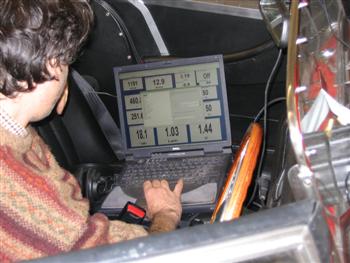 On
the electronics options, I agreed that in wanting to get the spanners
out myself, actually I was probably in somewhat of a minority - and in
fact most owners probably would readily trade the ability to fiddle for
the eco-friendly advantages of a Euro 4 compliant engine. Kevin then pointed
out that far from having a sealed factory management system, they had selected
a bespoke solution which was capable of being tuned via a laptop. Realizing
that this opens up a whole new opportunity for fiddling (sorry, "improving")
the engine oneself, I sensed Prejudice Number 1 starting to melt away.
On
the electronics options, I agreed that in wanting to get the spanners
out myself, actually I was probably in somewhat of a minority - and in
fact most owners probably would readily trade the ability to fiddle for
the eco-friendly advantages of a Euro 4 compliant engine. Kevin then pointed
out that far from having a sealed factory management system, they had selected
a bespoke solution which was capable of being tuned via a laptop. Realizing
that this opens up a whole new opportunity for fiddling (sorry, "improving")
the engine oneself, I sensed Prejudice Number 1 starting to melt away.
Let's take a look at the
car. The only outward clues that something is different are the right-hand
exhaust, the different gearshift, and a couple of extra warning lights
on the dash. Under the bonnet, the 1.8 VVTI Sport engine looks like it's
right at home, sitting on some new engine mounting brackets. But then would
we expect anything less from Kevin? Of course not.
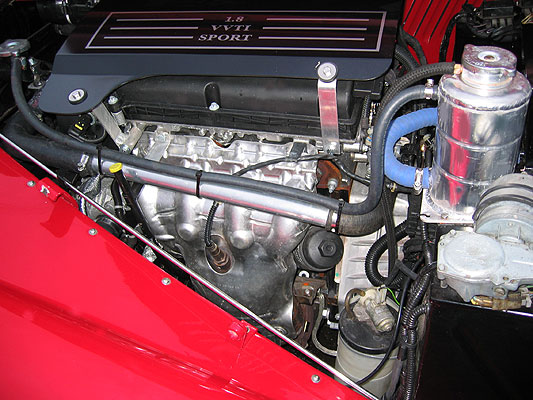 By
far the best thing from my point of view is that (a) it looks like a proper
engine, and (b) it doesn't say 'Vauxhall' anywhere. Prejudice number 2
not to like this car is now crossed off. The installation is pretty neat
- there's a induction box sat above the radiator, the plumbing is all nicely
integrated with the stock setup, and the exhaust system wraps neatly under
the engine and exits down the right side of the car. There's a hydraulic
clutch instead of the cable version on the CVH engine, and the ECU, together
with a distribution panel, are tucked up away under the dash. A high pressure
in-tank fuel pump is also needed to keep the injectors happy.
By
far the best thing from my point of view is that (a) it looks like a proper
engine, and (b) it doesn't say 'Vauxhall' anywhere. Prejudice number 2
not to like this car is now crossed off. The installation is pretty neat
- there's a induction box sat above the radiator, the plumbing is all nicely
integrated with the stock setup, and the exhaust system wraps neatly under
the engine and exits down the right side of the car. There's a hydraulic
clutch instead of the cable version on the CVH engine, and the ECU, together
with a distribution panel, are tucked up away under the dash. A high pressure
in-tank fuel pump is also needed to keep the injectors happy.
Prejudice number 3 was destroyed
over the next hour in an orgy of revs, speed, and excitement - but more
on that later.
A bit of background first.
The whole project was initiated by the serendipitous confluence of a number
of factors: Firstly, there was the notion that there are lots of 4/4 owners
out there who have an emotional attachment ot their cars, but would like
more performance. Secondly there was the availability of emissions-compliant
engines in affordable form from GM, and thirdly the desire to produce a
kit to enable these transverse engines to be mounted in longitudinal format
to enable a range of kit-car installations. Couple these to the growing
need to start offering an engine solution that will provide an environmentally-responsible
installation, and a plan emerges.
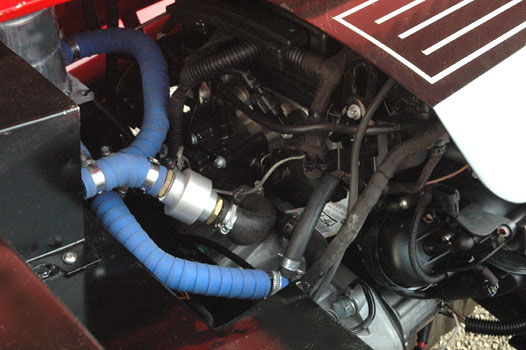 Accordingly,
a 1984 4/4 was purchased, and a 1.8 DOHC Variable valve-timed engine rated
at 175 bhp was mated to a 5-speed Omega gearbox and dropped into place.
Brakes were uprated with High-Spec twin piston alloy calipers to keep pace
with the massive power increase over a stock 4/4, and the master cylinder
seals were renewed. Off to the rolling road for tuning, and an impressive
147 bhp at the wheels was measured. The setup still isn't perfect: the
cold start system isn't quite right, and the electronic throttle "takes
a bit of getting used to" according to Kevin.
Accordingly,
a 1984 4/4 was purchased, and a 1.8 DOHC Variable valve-timed engine rated
at 175 bhp was mated to a 5-speed Omega gearbox and dropped into place.
Brakes were uprated with High-Spec twin piston alloy calipers to keep pace
with the massive power increase over a stock 4/4, and the master cylinder
seals were renewed. Off to the rolling road for tuning, and an impressive
147 bhp at the wheels was measured. The setup still isn't perfect: the
cold start system isn't quite right, and the electronic throttle "takes
a bit of getting used to" according to Kevin.
So: out for a test drive.
For the first few moments, I took things extremely gently, Kevin's warning
about the fly-by-wire throttle still ringing in my ears. What is this car
going to be like? I had brought a dictaphone to record my thoughts as I
drove.
My voice recorder tape is
somewhat revealing, you can hear 3 voices - me, Jane, (Tim's
better half! MW) and the car.
Me: "Quite a long clutch
travel, it bites about half way up"
Car: "Bwaaa" (rising revs)
Me: "He He!"
Car: "BWAAA" (right on the
cam)
Me: "'kin 'ell"
Jane: "Steady!"
Me: "Jesus wept, this thing
accelerates like a missile!"
Car: "BWAAAAAAAA"
The rest of the tape is a
rather entertaining mixture of engine sounds, me cackling with glee, and
the occasional excited squeal from Jane.
Jeez, but this thing is good.
I already have the High-Spec brake calipers on my tired old 1986 CVH car,
so I was expecting the vast improvement in the brakes. I also have decent
shocks and springs, so my car handles pretty well too. The difference,
and by golly it's a big difference, is the engine. Prod the throttle in
2nd, and it's just instant violence. None of the relaxed unstoppable steady
torquey rush of a Plus 8 as it hurls itself towards the horizon, this thing
kicks like a stinger missile, sharp and concentrated, precisely targeted.
It's a 2-ounce espresso compared to the Plus 8's pint of Americano - not
so much of it, but so much more concentrated - it hits the spot, and is
ultimately just as satisfying (if not more so!) than the larger quantity
delivery from the V8 car.
Blasting down a twisty 'B'
road, flipping between 3rd and 4th, flinging the thing into bends, chasing
the vanishing point, catching the tail as it steps out, booting the throttle
just for the thrill of listening to the way the revs spin up. Does life
get any better than this? I think not. The 4/4 steering box gives high-geared
but light steering with 1 and a half turns lock to lock. This, coupled
with the narrowness of the car and its light weight means you are dueling
with an epee rather than a sabre. And on twisty narrow roads, there are
few better weapons to use.
Onto the dual carriageway.
Let's see what it can do. Yee Haa! I've never seen the speedo needle so
far round the dial on a 4/4. Alright, the speedo hasn't yet been calibrated
to suit the drive from the Omega 5-speed box, and there's no way I'm really
doing 130 mph plus. But then again the 60 mph mark painted onto the dial
by Kevin as a guide is way way behind, not much more than halfway round
the needle's arc. And we're still gathering speed! But fortunately for
my license, we run out of space, and a return to more sensible speeds is
required. Has this car got too much power? No. Not quite. Prejudice number
3 is swept away.
So. The car accelerates with
a rush, handles beautifully, stops well, and cruises over the ton with
no sweat. Surely there must be some downsides? Well, yes.
 The
induction roar is quite frankly tinny sounding. The exhaust is too quiet.
Most annoyingly, the revs spin up fast like a racer, but hang on the way
back down. I wondered if a lighter flywheel might help, but Kevin thinks
it could be improved through adjusting the fueling map. And if you go for
the Omega 5 speed box, you'd better have small feet - or at least not the
desert-boots I was wearing - there's really not much room in the pedal
box. Kevin also reckons the Omega gearbox is whiny, To be frank, I didn't
notice it.
The
induction roar is quite frankly tinny sounding. The exhaust is too quiet.
Most annoyingly, the revs spin up fast like a racer, but hang on the way
back down. I wondered if a lighter flywheel might help, but Kevin thinks
it could be improved through adjusting the fueling map. And if you go for
the Omega 5 speed box, you'd better have small feet - or at least not the
desert-boots I was wearing - there's really not much room in the pedal
box. Kevin also reckons the Omega gearbox is whiny, To be frank, I didn't
notice it.
But hey, this is the first
car, the development mule. Next up will be a conversion using a Type 9
5-speed box (like in the later 4/4s), then hopefully a left-hand drive
version. Various exhaust options will be explored, maybe with a larger-diameter
pipe. Meanwhile there will be more work done on the ignition map, and various
other tweaks and improvements, based on the feedback Kevin's getting from
the people who are driving the test car.
Shortly after that, accountant
willing, Kevin will be converting my own car. I have confronted my prejudices,
and found them wanting. The car, I have not.
If you too have a 4/4 with
a tired engine, but like me you don't want to get rid of your beloved,
then you could do much worse than to beat a path to Market Drayton. The
team at Tudor Motor Bodies will be only too happy to put a big smile on
your face.
Tim
 A
General Motors 4/4!
A
General Motors 4/4!

 Once
seated in the car with hood down and ¾ tonneau in place it only
remained to familiarize myself with the difference between the test car
interior and my own. Seating was not quite as I would like being
used to fully adjustable plus 8 type seats in my own 4/4/4. Gear
lever position felt good, pedals OK, apart from lack of rubber on the brake
pedal.
Once
seated in the car with hood down and ¾ tonneau in place it only
remained to familiarize myself with the difference between the test car
interior and my own. Seating was not quite as I would like being
used to fully adjustable plus 8 type seats in my own 4/4/4. Gear
lever position felt good, pedals OK, apart from lack of rubber on the brake
pedal.
 By
far the best thing from my point of view is that (a) it looks like a proper
engine, and (b) it doesn't say 'Vauxhall' anywhere. Prejudice number 2
not to like this car is now crossed off. The installation is pretty neat
- there's a induction box sat above the radiator, the plumbing is all nicely
integrated with the stock setup, and the exhaust system wraps neatly under
the engine and exits down the right side of the car. There's a hydraulic
clutch instead of the cable version on the CVH engine, and the ECU, together
with a distribution panel, are tucked up away under the dash. A high pressure
in-tank fuel pump is also needed to keep the injectors happy.
By
far the best thing from my point of view is that (a) it looks like a proper
engine, and (b) it doesn't say 'Vauxhall' anywhere. Prejudice number 2
not to like this car is now crossed off. The installation is pretty neat
- there's a induction box sat above the radiator, the plumbing is all nicely
integrated with the stock setup, and the exhaust system wraps neatly under
the engine and exits down the right side of the car. There's a hydraulic
clutch instead of the cable version on the CVH engine, and the ECU, together
with a distribution panel, are tucked up away under the dash. A high pressure
in-tank fuel pump is also needed to keep the injectors happy.
 Accordingly,
a 1984 4/4 was purchased, and a 1.8 DOHC Variable valve-timed engine rated
at 175 bhp was mated to a 5-speed Omega gearbox and dropped into place.
Brakes were uprated with High-Spec twin piston alloy calipers to keep pace
with the massive power increase over a stock 4/4, and the master cylinder
seals were renewed. Off to the rolling road for tuning, and an impressive
147 bhp at the wheels was measured. The setup still isn't perfect: the
cold start system isn't quite right, and the electronic throttle "takes
a bit of getting used to" according to Kevin.
Accordingly,
a 1984 4/4 was purchased, and a 1.8 DOHC Variable valve-timed engine rated
at 175 bhp was mated to a 5-speed Omega gearbox and dropped into place.
Brakes were uprated with High-Spec twin piston alloy calipers to keep pace
with the massive power increase over a stock 4/4, and the master cylinder
seals were renewed. Off to the rolling road for tuning, and an impressive
147 bhp at the wheels was measured. The setup still isn't perfect: the
cold start system isn't quite right, and the electronic throttle "takes
a bit of getting used to" according to Kevin.
 The
induction roar is quite frankly tinny sounding. The exhaust is too quiet.
Most annoyingly, the revs spin up fast like a racer, but hang on the way
back down. I wondered if a lighter flywheel might help, but Kevin thinks
it could be improved through adjusting the fueling map. And if you go for
the Omega 5 speed box, you'd better have small feet - or at least not the
desert-boots I was wearing - there's really not much room in the pedal
box. Kevin also reckons the Omega gearbox is whiny, To be frank, I didn't
notice it.
The
induction roar is quite frankly tinny sounding. The exhaust is too quiet.
Most annoyingly, the revs spin up fast like a racer, but hang on the way
back down. I wondered if a lighter flywheel might help, but Kevin thinks
it could be improved through adjusting the fueling map. And if you go for
the Omega 5 speed box, you'd better have small feet - or at least not the
desert-boots I was wearing - there's really not much room in the pedal
box. Kevin also reckons the Omega gearbox is whiny, To be frank, I didn't
notice it.